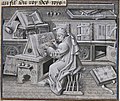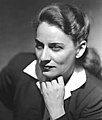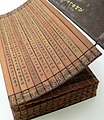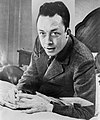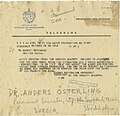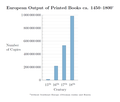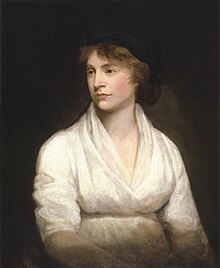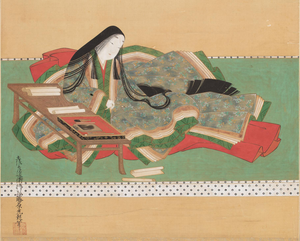Portal:Literature
Introduction
Literature, as an art form, can also include works in various
General images -
-
A 15th-century Incunable. Notice the blind-tooled cover, corner bosses, and clasps. (from History of books)
-
Gabriel García Márquez, one of the most renowned Latin American writers (from Latin American literature)
-
The Frog Prince, 1874. (from Children's literature)
-
A Tagore illustration of a Hindu myth (from Children's literature)
-
Kings' Fairy Tale, 1909, by Mikalojus Konstantinas Čiurlionis (from Fairy tale)
-
Illustration from Robert Louis Stevenson's 1883 pirate adventure Treasure Island (from Children's literature)
-
Page from the Blue Quran manuscript, ca. 9th or 10th century CE (from History of books)
-
Octavio Paz helped to define modern poetry and the Mexican personality. (from Latin American literature)
-
Pages from the 1819 edition of Kinder- und Haus-Märchen by the Brothers Grimm (from Children's literature)
-
Woman holding wax tablets in the form of the codex. Wall painting from Pompeii, before 79 CE. (from History of books)
-
The European fairy tale Little Red Riding Hood and the Wolf in a painting by Carl Larsson in 1881. (from Fairy tale)
-
12-metre-high (40 ft) stack of books sculpture at the Berlin Walk of Ideas, commemorating the invention of modern book printing (from History of books)
-
The character which means "poetry", in the ancient Chinese )
-
European output of manuscripts 500–1500 (from History of books)
-
An author portrait of Jean Miélot writing his compilation of the Miracles of Our Lady, one of his many popular works. (from History of books)
-
The Violet Fairy Book (1906)
-
Father Frost acts as a donor in the Russian fairy tale Father Frost, testing the heroine before bestowing riches upon her (from Fairy tale)
-
The New England Primer (from Children's literature)
-
Cutlery for children. Detail showing fairy-tale scenes: Snow White, Little Red Riding Hood, Hansel and Gretel. (from Fairy tale)
-
Statuta Mutine Reformata, 1420–1485; parchment codex bound in wood and leather with brass plaques worked the corners and in the center, with clasps. (from Medieval literature)
-
Folio from the Shah Jahan Album, c. 1620, depicting the Mughal Emperor Shah Jahan (from History of books)
-
J. K. Rowling reads from her novel Harry Potter and the Philosopher's Stone (from Children's literature)
-
A mother reads to her children, depicted by Jessie Willcox Smith in a cover illustration of a volume of fairy tales written in the mid to late 19th century. (from Children's literature)
-
The former Canadian Parliamentary Poet Laureate George Elliott Clarke (2015) (from Canadian literature)
-
Gabrielle Roy was a notable French Canadian author. (from Canadian literature)
-
AOriental Institute at the University of Chicago, inscribed with the text of the poem Inanna and Ebih by the priestess Enheduanna, the first author whose name is known
-
Dresden Codex (page 49) (from History of books)
-
)
-
Illustration from Alice's Adventures in Wonderland, 1865 (from Children's literature)
-
A late 18th-century reprint ofComenius, the first children's picture book. (from Children's literature)
-
The scene in Botticelli's Madonna of the Book (1480) reflects the presence of books in the houses of richer people in his time. (from History of books)
-
Peruvian poet César Vallejo, considered by Thomas Merton "the greatest universal poet since Dante" (from Latin American literature)
-
The Codex Manesse, a German book from the Middle Ages (from History of books)
-
H. O. Tanager performs at a bookstore in Boise, Idaho. (from Performance poetry)
-
Postal stamp of Russia celebrating children's books. (from Children's literature)
-
Page from a Jain manuscript depicting the birth of Mahavira, c. 1400 (from History of books)
-
John Bauer's illustration of trolls and a princess from a collection of Swedish fairy tales (from Fairy tale)
-
Roberto Bolaño is considered to have had the greatest United States impact of any post-Boom author (from Latin American literature)
-
A poet with a few enraptured fans (from Performance poetry)
-
Statue of C. S. Lewis in front of the wardrobe from his Narnia book The Lion, the Witch and the Wardrobe (from Children's literature)
-
Folio from a manuscript of the Shanamah (Book of Kings) (from History of books)
-
The Adventures of Pinocchio (1883) is a canonical piece of children's literature and one of the best-selling books ever published. (from Children's literature)
-
European output of books 500–1800 (from History of books)
-
Natias Neutert performing Diogenes Synopsis as at Künstlerhaus Bethanien Berlin, 1986 (from Performance poetry)
-
Handwritten notes by Christopher Columbus on a Latin edition of The Travels of Marco Polo (from Travel literature)
-
Statue of Minnie the Minx, a character from The Beano. Launched in 1938, the comic is known for its anarchic humour, with Dennis the Menace appearing on the cover. (from Children's literature)
-
Number of children's books titles published by the trade sector in 2020 (from Children's literature)
-
In 1901, French poet and essayist Sully Prudhomme (1839–1907) was the first person to be awarded the Nobel Prize in Literature, "in special recognition of his poetic composition, which gives evidence of lofty idealism, artistic perfection, and a rare combination of the qualities of both heart and intellect." (from Nobel Prize in Literature)
-
A Chinese bamboo book (from History of books)
-
Newbery Award winner (from Children's literature)
-
Willy Wonka (from Roald Dahl's Charlie and the Chocolate Factory), and the Mad Hatter (from Lewis Carroll's Alice's Adventures in Wonderland) in London (from Children's literature)
-
The Book of the Dead of Hunefer, c. 1275 BCE, ink and pigments on papyrus, in the British Museum (London) (from History of books)
-
Sculpture of Alfonso Reyes writer of influential pieces of Mexican surrealism. (from Latin American literature)
-
French author Albert Camus was the first African-born writer to receive the award. (from Nobel Prize in Literature)
-
Hemingway's telegram in 1954 (the academy has alternately used for Literature and in Literature over the years, the latter becoming the norm today) (from Nobel Prize in Literature)
-
The Crescent Moon by Rabindranath Tagore illus. by Nandalal Bose, Macmillan 1913 (from Children's literature)
-
Ivan Bilibin (1876-1942)'s illustration of the Russian fairy tale about Vasilisa the Beautiful (from Fairy tale)
-
Hugo Ball performing at the Cabaret Voltaire (from Performance poetry)
-
Newbery's A Little Pretty Pocket-Book, originally published in 1744 (from Children's literature)
-
Jikji, Selected Teachings of Buddhist Sages and Seon Masters, the earliest known book printed with movable metal type, 1377.Bibliothèque Nationale de France, Paris. (from History of books)
-
The first page of Beowulf (from Medieval literature)
-
Photograph of a printing press in Egypt, c. 1922 (from History of books)
-
European output of printed books c. 1450–1800 (from History of books)
-
An early Mexican hornbook pictured in Tuer's History of the Horn-Book, 1896. (from Children's literature)
-
Estimated medieval output of manuscripts in terms of copies (from Medieval literature)
-
1900 edition of the controversial The Story of Little Black Sambo (from Children's literature)
-
Goethe's Italian Journey between September 1786 and May 1788 (from Travel literature)
-
Charles G. D. Roberts was a poet that belonged to an informal group known as the Confederation Poets. (from Canadian literature)
-
muse of heroic poetry (from History of poetry)
The Diary of a Nobody is an English comic novel written by the brothers George and Weedon Grossmith, with illustrations by the latter. It originated as an intermittent serial in Punch magazine in 1888–89 and first appeared in book form, with extended text and added illustrations, in 1892. The Diary records the daily events in the lives of a London clerk, Charles Pooter, his wife Carrie, his son Lupin, and numerous friends and acquaintances over a period of 15 months.
Although its initial public reception was muted, the Diary came to be recognised by critics as a classic work of humour, and it has never been out of print. It helped to establish a genre of humorous popular fiction based on lower or lower-middle class aspirations, and was the forerunner of numerous fictitious diary novels in the later 20th century. The Diary has been the subject of several stage and screen adaptations, including Ken Russell's "silent film" treatment of 1964, a four-part TV film scripted by Andrew Davies in 2007, and a widely praised stage version in 2011, in which an all-male cast of three played all the parts.
















